Maine Skies
Astronomy ---- Equipment
 The telescope is mounted on a concrete pier
inside of a roll-off roof observatory
in my back yard. Observatory equipment consists of a
variety of components that allow both visual observing and imaging of
night
sky objects. The primary parts are: the
Astro-Physics Starfire 152 telescope, the mount to hold and
point the scope is a Losmandy G11 German Equatorial Mount, which is
supported by a concrete pier for excellent stability.
A variety of Nagler eyepieces are used in the telescope's eyepiece
holder for higher or lower magnification. Also the SBIG ST2000XM
ccd camera can be mounted in place of an eyepiece to take exposures of
night objects. A few other parts help out such
as the RoboFocus, a computer controlled focuser which allows for very
precise control of the focus. Kendrick dew heaters that wrap
around the telescope's objective lens keep it just a little warmer
than the surrounding air and prevents dew from forming on the critical
optical part. Of course, no amateur observatory would
be without a computer to tie it all together and allow remote control
of it all.
The telescope is mounted on a concrete pier
inside of a roll-off roof observatory
in my back yard. Observatory equipment consists of a
variety of components that allow both visual observing and imaging of
night
sky objects. The primary parts are: the
Astro-Physics Starfire 152 telescope, the mount to hold and
point the scope is a Losmandy G11 German Equatorial Mount, which is
supported by a concrete pier for excellent stability.
A variety of Nagler eyepieces are used in the telescope's eyepiece
holder for higher or lower magnification. Also the SBIG ST2000XM
ccd camera can be mounted in place of an eyepiece to take exposures of
night objects. A few other parts help out such
as the RoboFocus, a computer controlled focuser which allows for very
precise control of the focus. Kendrick dew heaters that wrap
around the telescope's objective lens keep it just a little warmer
than the surrounding air and prevents dew from forming on the critical
optical part. Of course, no amateur observatory would
be without a computer to tie it all together and allow remote control
of it all.
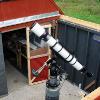 The Astro-Physics StarFire 152 telescope is the heart of the whole
system. Although this scope is new to me, it is 15 years
old, the previous owners kept it in outstanding condition (thanks
Rick!). I am on the waiting list with AP for a new one, but
the wait is at least 4 or 5 years!
The Astro-Physics StarFire 152 telescope is the heart of the whole
system. Although this scope is new to me, it is 15 years
old, the previous owners kept it in outstanding condition (thanks
Rick!). I am on the waiting list with AP for a new one, but
the wait is at least 4 or 5 years!
Astro-Physics is world renowned for making optics that are second to
none, and overall quality that is
just as outstanding. It is literally the one to which
others
are compared. I have owned 5 telescopes and viewed through many
others; this one absolutely outdoes them all in it's ability to make
stars look like pinpoints, make detail on planets and the moon stand
out incredibly, and shows awesome depth and clarity on Nebulas and
Galaxies. Technical specifications for the scope: 6 inch (152 mm)
f/9
Apochromat Magnesium fluoride coated objective lens, with
96.5% light transmission;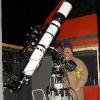 1300 mm focal length and about 5 feet in
overall length, the weight is 20 lbs. It gathers 460 times
as much light as the unaided human eye.
1300 mm focal length and about 5 feet in
overall length, the weight is 20 lbs. It gathers 460 times
as much light as the unaided human eye.
This photo with my ugly mug in the background was taken at about 1am
while imaging a spiral galaxy near the big dipper.
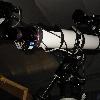 The addition of a second camera and telescope
complete the setup of a
guide scope. A 70mm (2.7 inch dia) TeleVue Pronto telescope
and an
SBIG ST5C camera are used to autoguide the telescope's
mount. The
guide scope watches the position of a single star and if the star
'moves' then the telescope mount is given a correction to its position,
putting the guide star back in the correct spot.
Autoguiding allows
for very long imaging times with the primary telescope and
camera.
The first successful image using this setup was 50 minutes in duration
and shows a nice image of M1, the
Crab Nebula.
The addition of a second camera and telescope
complete the setup of a
guide scope. A 70mm (2.7 inch dia) TeleVue Pronto telescope
and an
SBIG ST5C camera are used to autoguide the telescope's
mount. The
guide scope watches the position of a single star and if the star
'moves' then the telescope mount is given a correction to its position,
putting the guide star back in the correct spot.
Autoguiding allows
for very long imaging times with the primary telescope and
camera.
The first successful image using this setup was 50 minutes in duration
and shows a nice image of M1, the
Crab Nebula.
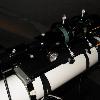 This
image shows the guide scope up close. The Pronto is held in place
by two rings with 3 long thumb screw in each ring. This allows
the guide scope to be aligned to point in the exact same location as
the primary scope. It is a sturdy mounting method that
allows for adjustment and at the same time eliminates any possible
flexture between the two telescopes. Lack of flexture
is critical in autoguiding accuracy.
This
image shows the guide scope up close. The Pronto is held in place
by two rings with 3 long thumb screw in each ring. This allows
the guide scope to be aligned to point in the exact same location as
the primary scope. It is a sturdy mounting method that
allows for adjustment and at the same time eliminates any possible
flexture between the two telescopes. Lack of flexture
is critical in autoguiding accuracy.
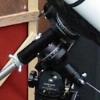 The Losmandy G11 Equatorial mount provides very stable and
accurately controlled pointing of the telescope. It uses a Gemini controller which connects
the azimuth and declination motors, a hand held controller, connects to
the CCD autoguider and to the PC. The Gemini has a built-in
database of about 41,000 objects and is capable of a variety of methods
to
improve the pointing and tracking accuracy of the mount. It
is capable of supporting a payload of up to 60 lbs.
The Losmandy G11 Equatorial mount provides very stable and
accurately controlled pointing of the telescope. It uses a Gemini controller which connects
the azimuth and declination motors, a hand held controller, connects to
the CCD autoguider and to the PC. The Gemini has a built-in
database of about 41,000 objects and is capable of a variety of methods
to
improve the pointing and tracking accuracy of the mount. It
is capable of supporting a payload of up to 60 lbs.
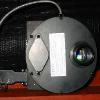 The CCD camera
is made by SBIG and is the ST2000XM
model. It
attaches to the telescope via a nosepiece that fits into the
telescope's eyepiece
holder. The camera has a black & white 1600 x 1200 CCD chip
for imaging and a smaller second chip for autoguiding. The
st2k has a built-in refrigeration system to cool the imaging
chip. The colder the chip is the better the signal-to-noise ratio
is, which means a cleaner picture. In order to take a color
image, the camera has to take a picture with a red filter in place,
then green, then blue. The built-in color filter wheel provides
color filters and a hydrogen alpha filter. The RGB set is
combined into a color
image. Beyond RGB color images, luminance images are
used to show more detail, then the RGBs are added to color the
image.
The CCD camera
is made by SBIG and is the ST2000XM
model. It
attaches to the telescope via a nosepiece that fits into the
telescope's eyepiece
holder. The camera has a black & white 1600 x 1200 CCD chip
for imaging and a smaller second chip for autoguiding. The
st2k has a built-in refrigeration system to cool the imaging
chip. The colder the chip is the better the signal-to-noise ratio
is, which means a cleaner picture. In order to take a color
image, the camera has to take a picture with a red filter in place,
then green, then blue. The built-in color filter wheel provides
color filters and a hydrogen alpha filter. The RGB set is
combined into a color
image. Beyond RGB color images, luminance images are
used to show more detail, then the RGBs are added to color the
image.
The camera can take a picture as quick as 0.01 second or expose for as
long as an hour or anywhere in between. Very bright
objects like the moon or a bright planet get a short image time usually
about .01 second for the moon and .03 to .05 second for jupiter or
mars. Distant and dim objects like galaxies, clusters and 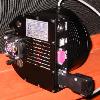 nebula
require a longer exposure time and generally, the longer the image time
the more detail appears in it. This view of the back
side shows where the cooling fan and optional water cooling system
connectors are. Also the connectors can be seen that hook the
camera up to the PC, telescope mount and power.
nebula
require a longer exposure time and generally, the longer the image time
the more detail appears in it. This view of the back
side shows where the cooling fan and optional water cooling system
connectors are. Also the connectors can be seen that hook the
camera up to the PC, telescope mount and power.
One of the camera's best features is the second ccd chip used for
autoguiding. Over time, a star or object being imaged
may drift. The slightest drift off course shows up in an image
that make stars look like eggs or worse worms. The
autoguider watches a single star repeatedly taking an image of
it. If the star moves offset from it's initial position, the
camera tells the telescope how to move it back in position.
This process happens continuously while the main ccd chip is exposing
an image. Using the autoguider, very long
exposure times can be reached. I have imaged for as
long as 30 minutes in a single shot with perfectly round
stars. A typical unguided image is one minute or less.
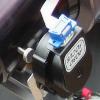 The RoboFocus
is a motorizes the telescope's focuser and is controlled by either a hand held
controller or the PC. It was an enormous help in achieving
both a repeatable sharp focus, and doing so way more quickly than
by hand. It can move the focuser knob with far more granular
movements
than the human hand can, and it remembers where the sharpest setting is
for any eyepiece or camera setup. This addition went
on my old telescope and then upgraded it to fit on the StarFire's
focuser. The CCDSoft program that is used on the PC
to expose images on the camera has a function called @focus that will
move the focuser around and take pictures and figure out where the
sharpest focus and leave the telescope there.
The RoboFocus
is a motorizes the telescope's focuser and is controlled by either a hand held
controller or the PC. It was an enormous help in achieving
both a repeatable sharp focus, and doing so way more quickly than
by hand. It can move the focuser knob with far more granular
movements
than the human hand can, and it remembers where the sharpest setting is
for any eyepiece or camera setup. This addition went
on my old telescope and then upgraded it to fit on the StarFire's
focuser. The CCDSoft program that is used on the PC
to expose images on the camera has a function called @focus that will
move the focuser around and take pictures and figure out where the
sharpest focus and leave the telescope there.
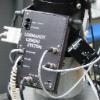 The Gemini control module for the Losmandy G11 mount
is shown here along with the Kendrick dew controller. The Gemini
is the heart of the control system for pointing the
telescope. It has a variety of features that enable
very accurate control. For example, although it knows
approximately where things in the sky are, any inaccuracy in polar
alignment will result in the same inaccuracy in finding
objects. The Gemini can build a model the pointing
characteristics of the mount. This is done by centering 6 or more
stars (one at a time) in the eyepiece and telling Gemini
that it's now centered on each one. The more stars that are added
to the pointing model, the more accurate the mount becomes with told to
slew to a particular object. I have found that after
4 or 5 alignment stars are added to the model, it always nails
subsequent objects dead center when told to slew to them.
The Gemini control module for the Losmandy G11 mount
is shown here along with the Kendrick dew controller. The Gemini
is the heart of the control system for pointing the
telescope. It has a variety of features that enable
very accurate control. For example, although it knows
approximately where things in the sky are, any inaccuracy in polar
alignment will result in the same inaccuracy in finding
objects. The Gemini can build a model the pointing
characteristics of the mount. This is done by centering 6 or more
stars (one at a time) in the eyepiece and telling Gemini
that it's now centered on each one. The more stars that are added
to the pointing model, the more accurate the mount becomes with told to
slew to a particular object. I have found that after
4 or 5 alignment stars are added to the model, it always nails
subsequent objects dead center when told to slew to them.
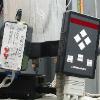 The hand held controllers shown here are the
RoboFocus on the left and the Gemini on the right.
Both are velcro'd to the base plate for easy access and storage in the
dark.
The hand held controllers shown here are the
RoboFocus on the left and the Gemini on the right.
Both are velcro'd to the base plate for easy access and storage in the
dark.
 The previous telescope was an
Meade LX-200 10" Schmidt-Cassegrain. I used it for
about 3 years and learned a lot about astronomy, telescopes and imaging
with it. It's 10 inch arpeture gathered enough light to be
able to visualy see magnitude 13 galaxies and pluto at mag 13.8!
The previous telescope was an
Meade LX-200 10" Schmidt-Cassegrain. I used it for
about 3 years and learned a lot about astronomy, telescopes and imaging
with it. It's 10 inch arpeture gathered enough light to be
able to visualy see magnitude 13 galaxies and pluto at mag 13.8!
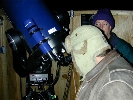 Dan looks through the LX-200 on New Year's Eve
2001. It was a balmy 10 below zero that night, somewhat
warmer than it would be later in the season. The sky
was sharp as we looked at Jupiter, Saturn and a variety of
galaxies and clusters.
Dan looks through the LX-200 on New Year's Eve
2001. It was a balmy 10 below zero that night, somewhat
warmer than it would be later in the season. The sky
was sharp as we looked at Jupiter, Saturn and a variety of
galaxies and clusters.
 The telescope is mounted on a concrete pier
inside of a roll-off roof observatory
in my back yard. Observatory equipment consists of a
variety of components that allow both visual observing and imaging of
night
sky objects. The primary parts are: the
Astro-Physics Starfire 152 telescope, the mount to hold and
point the scope is a Losmandy G11 German Equatorial Mount, which is
supported by a concrete pier for excellent stability.
A variety of Nagler eyepieces are used in the telescope's eyepiece
holder for higher or lower magnification. Also the SBIG ST2000XM
ccd camera can be mounted in place of an eyepiece to take exposures of
night objects. A few other parts help out such
as the RoboFocus, a computer controlled focuser which allows for very
precise control of the focus. Kendrick dew heaters that wrap
around the telescope's objective lens keep it just a little warmer
than the surrounding air and prevents dew from forming on the critical
optical part. Of course, no amateur observatory would
be without a computer to tie it all together and allow remote control
of it all.
The telescope is mounted on a concrete pier
inside of a roll-off roof observatory
in my back yard. Observatory equipment consists of a
variety of components that allow both visual observing and imaging of
night
sky objects. The primary parts are: the
Astro-Physics Starfire 152 telescope, the mount to hold and
point the scope is a Losmandy G11 German Equatorial Mount, which is
supported by a concrete pier for excellent stability.
A variety of Nagler eyepieces are used in the telescope's eyepiece
holder for higher or lower magnification. Also the SBIG ST2000XM
ccd camera can be mounted in place of an eyepiece to take exposures of
night objects. A few other parts help out such
as the RoboFocus, a computer controlled focuser which allows for very
precise control of the focus. Kendrick dew heaters that wrap
around the telescope's objective lens keep it just a little warmer
than the surrounding air and prevents dew from forming on the critical
optical part. Of course, no amateur observatory would
be without a computer to tie it all together and allow remote control
of it all.  The Astro-Physics StarFire 152 telescope is the heart of the whole
system. Although this scope is new to me, it is 15 years
old, the previous owners kept it in outstanding condition (thanks
Rick!). I am on the waiting list with AP for a new one, but
the wait is at least 4 or 5 years!
The Astro-Physics StarFire 152 telescope is the heart of the whole
system. Although this scope is new to me, it is 15 years
old, the previous owners kept it in outstanding condition (thanks
Rick!). I am on the waiting list with AP for a new one, but
the wait is at least 4 or 5 years!  1300 mm focal length and about 5 feet in
overall length, the weight is 20 lbs. It gathers 460 times
as much light as the unaided human eye.
1300 mm focal length and about 5 feet in
overall length, the weight is 20 lbs. It gathers 460 times
as much light as the unaided human eye.  The addition of a second camera and telescope
complete the setup of a
guide scope. A 70mm (2.7 inch dia) TeleVue Pronto telescope
and an
SBIG ST5C camera are used to autoguide the telescope's
mount. The
guide scope watches the position of a single star and if the star
'moves' then the telescope mount is given a correction to its position,
putting the guide star back in the correct spot.
Autoguiding allows
for very long imaging times with the primary telescope and
camera.
The first successful image using this setup was 50 minutes in duration
and shows a nice image of M1, the
Crab Nebula.
The addition of a second camera and telescope
complete the setup of a
guide scope. A 70mm (2.7 inch dia) TeleVue Pronto telescope
and an
SBIG ST5C camera are used to autoguide the telescope's
mount. The
guide scope watches the position of a single star and if the star
'moves' then the telescope mount is given a correction to its position,
putting the guide star back in the correct spot.
Autoguiding allows
for very long imaging times with the primary telescope and
camera.
The first successful image using this setup was 50 minutes in duration
and shows a nice image of M1, the
Crab Nebula. This
image shows the guide scope up close. The Pronto is held in place
by two rings with 3 long thumb screw in each ring. This allows
the guide scope to be aligned to point in the exact same location as
the primary scope. It is a sturdy mounting method that
allows for adjustment and at the same time eliminates any possible
flexture between the two telescopes. Lack of flexture
is critical in autoguiding accuracy.
This
image shows the guide scope up close. The Pronto is held in place
by two rings with 3 long thumb screw in each ring. This allows
the guide scope to be aligned to point in the exact same location as
the primary scope. It is a sturdy mounting method that
allows for adjustment and at the same time eliminates any possible
flexture between the two telescopes. Lack of flexture
is critical in autoguiding accuracy.  The Losmandy G11 Equatorial mount provides very stable and
accurately controlled pointing of the telescope. It uses a Gemini controller which connects
the azimuth and declination motors, a hand held controller, connects to
the CCD autoguider and to the PC. The Gemini has a built-in
database of about 41,000 objects and is capable of a variety of methods
to
improve the pointing and tracking accuracy of the mount. It
is capable of supporting a payload of up to 60 lbs.
The Losmandy G11 Equatorial mount provides very stable and
accurately controlled pointing of the telescope. It uses a Gemini controller which connects
the azimuth and declination motors, a hand held controller, connects to
the CCD autoguider and to the PC. The Gemini has a built-in
database of about 41,000 objects and is capable of a variety of methods
to
improve the pointing and tracking accuracy of the mount. It
is capable of supporting a payload of up to 60 lbs.  The CCD camera
is made by SBIG and is the ST2000XM
model. It
attaches to the telescope via a nosepiece that fits into the
telescope's eyepiece
holder. The camera has a black & white 1600 x 1200 CCD chip
for imaging and a smaller second chip for autoguiding. The
st2k has a built-in refrigeration system to cool the imaging
chip. The colder the chip is the better the signal-to-noise ratio
is, which means a cleaner picture. In order to take a color
image, the camera has to take a picture with a red filter in place,
then green, then blue. The built-in color filter wheel provides
color filters and a hydrogen alpha filter. The RGB set is
combined into a color
image. Beyond RGB color images, luminance images are
used to show more detail, then the RGBs are added to color the
image.
The CCD camera
is made by SBIG and is the ST2000XM
model. It
attaches to the telescope via a nosepiece that fits into the
telescope's eyepiece
holder. The camera has a black & white 1600 x 1200 CCD chip
for imaging and a smaller second chip for autoguiding. The
st2k has a built-in refrigeration system to cool the imaging
chip. The colder the chip is the better the signal-to-noise ratio
is, which means a cleaner picture. In order to take a color
image, the camera has to take a picture with a red filter in place,
then green, then blue. The built-in color filter wheel provides
color filters and a hydrogen alpha filter. The RGB set is
combined into a color
image. Beyond RGB color images, luminance images are
used to show more detail, then the RGBs are added to color the
image.  nebula
require a longer exposure time and generally, the longer the image time
the more detail appears in it. This view of the back
side shows where the cooling fan and optional water cooling system
connectors are. Also the connectors can be seen that hook the
camera up to the PC, telescope mount and power.
nebula
require a longer exposure time and generally, the longer the image time
the more detail appears in it. This view of the back
side shows where the cooling fan and optional water cooling system
connectors are. Also the connectors can be seen that hook the
camera up to the PC, telescope mount and power.  The RoboFocus
is a motorizes the telescope's focuser and is controlled by either a hand held
controller or the PC. It was an enormous help in achieving
both a repeatable sharp focus, and doing so way more quickly than
by hand. It can move the focuser knob with far more granular
movements
than the human hand can, and it remembers where the sharpest setting is
for any eyepiece or camera setup. This addition went
on my old telescope and then upgraded it to fit on the StarFire's
focuser. The CCDSoft program that is used on the PC
to expose images on the camera has a function called @focus that will
move the focuser around and take pictures and figure out where the
sharpest focus and leave the telescope there.
The RoboFocus
is a motorizes the telescope's focuser and is controlled by either a hand held
controller or the PC. It was an enormous help in achieving
both a repeatable sharp focus, and doing so way more quickly than
by hand. It can move the focuser knob with far more granular
movements
than the human hand can, and it remembers where the sharpest setting is
for any eyepiece or camera setup. This addition went
on my old telescope and then upgraded it to fit on the StarFire's
focuser. The CCDSoft program that is used on the PC
to expose images on the camera has a function called @focus that will
move the focuser around and take pictures and figure out where the
sharpest focus and leave the telescope there. The Gemini control module for the Losmandy G11 mount
is shown here along with the Kendrick dew controller. The Gemini
is the heart of the control system for pointing the
telescope. It has a variety of features that enable
very accurate control. For example, although it knows
approximately where things in the sky are, any inaccuracy in polar
alignment will result in the same inaccuracy in finding
objects. The Gemini can build a model the pointing
characteristics of the mount. This is done by centering 6 or more
stars (one at a time) in the eyepiece and telling Gemini
that it's now centered on each one. The more stars that are added
to the pointing model, the more accurate the mount becomes with told to
slew to a particular object. I have found that after
4 or 5 alignment stars are added to the model, it always nails
subsequent objects dead center when told to slew to them.
The Gemini control module for the Losmandy G11 mount
is shown here along with the Kendrick dew controller. The Gemini
is the heart of the control system for pointing the
telescope. It has a variety of features that enable
very accurate control. For example, although it knows
approximately where things in the sky are, any inaccuracy in polar
alignment will result in the same inaccuracy in finding
objects. The Gemini can build a model the pointing
characteristics of the mount. This is done by centering 6 or more
stars (one at a time) in the eyepiece and telling Gemini
that it's now centered on each one. The more stars that are added
to the pointing model, the more accurate the mount becomes with told to
slew to a particular object. I have found that after
4 or 5 alignment stars are added to the model, it always nails
subsequent objects dead center when told to slew to them. The hand held controllers shown here are the
RoboFocus on the left and the Gemini on the right.
Both are velcro'd to the base plate for easy access and storage in the
dark.
The hand held controllers shown here are the
RoboFocus on the left and the Gemini on the right.
Both are velcro'd to the base plate for easy access and storage in the
dark.